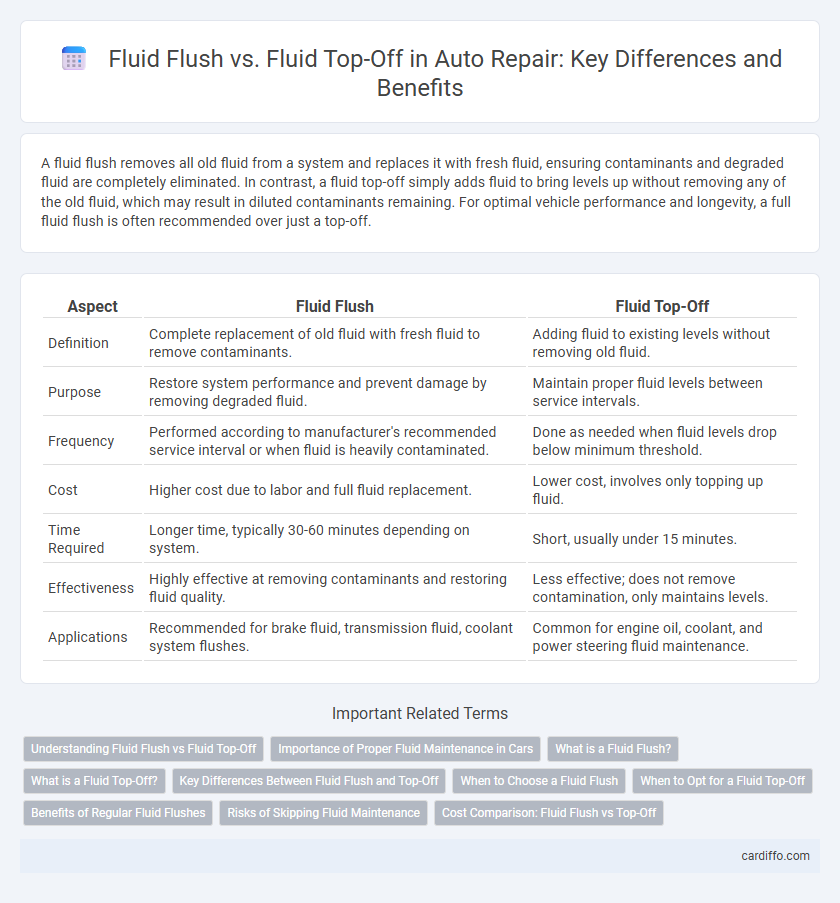A fluid flush removes all old fluid from a system and replaces it with fresh fluid, ensuring contaminants and degraded fluid are completely eliminated. In contrast, a fluid top-off simply adds fluid to bring levels up without removing any of the old fluid, which may result in diluted contaminants remaining. For optimal vehicle performance and longevity, a full fluid flush is often recommended over just a top-off.
Table of Comparison
| Aspect | Fluid Flush | Fluid Top-Off |
|---|---|---|
| Definition | Complete replacement of old fluid with fresh fluid to remove contaminants. | Adding fluid to existing levels without removing old fluid. |
| Purpose | Restore system performance and prevent damage by removing degraded fluid. | Maintain proper fluid levels between service intervals. |
| Frequency | Performed according to manufacturer's recommended service interval or when fluid is heavily contaminated. | Done as needed when fluid levels drop below minimum threshold. |
| Cost | Higher cost due to labor and full fluid replacement. | Lower cost, involves only topping up fluid. |
| Time Required | Longer time, typically 30-60 minutes depending on system. | Short, usually under 15 minutes. |
| Effectiveness | Highly effective at removing contaminants and restoring fluid quality. | Less effective; does not remove contamination, only maintains levels. |
| Applications | Recommended for brake fluid, transmission fluid, coolant system flushes. | Common for engine oil, coolant, and power steering fluid maintenance. |
Understanding Fluid Flush vs Fluid Top-Off
Fluid flush involves completely draining and replacing all old fluid to remove contaminants and restore optimal performance, while fluid top-off simply adds fresh fluid to an existing level without addressing potential buildup of debris or degraded fluid. Regular fluid flushes are essential for maintaining system efficiency and preventing costly repairs by eliminating accumulated sludge and contaminants. Fluid top-offs are a quick maintenance step that extends fluid life between flushes but cannot substitute for the comprehensive benefits of a full fluid flush.
Importance of Proper Fluid Maintenance in Cars
Regular fluid flushes remove contaminants and degraded fluids, ensuring optimal engine performance and longevity. Simply topping off fluids can mask underlying issues like leaks or contamination, leading to potential mechanical failures. Proper fluid maintenance, including scheduled flushes, is essential to preserving vehicle reliability and preventing costly repairs.
What is a Fluid Flush?
A fluid flush involves completely draining and replacing old automotive fluids such as engine oil, transmission fluid, or coolant to remove contaminants and ensure optimal performance. This process helps prevent system wear, overheating, and potential component failure by restoring fluid quality and maintaining proper lubrication or cooling. Fluid flushes are recommended at specific service intervals based on vehicle manufacturer guidelines and driving conditions.
What is a Fluid Top-Off?
A fluid top-off involves adding the necessary amount of fluid to a vehicle's system to ensure optimal performance without completely draining or replacing the existing fluid. This maintenance technique helps maintain proper fluid levels in components such as engine oil, brake fluid, coolant, or transmission fluid. Unlike a fluid flush, a top-off is a quicker, less invasive procedure designed to prevent contamination and retain the vehicle's current fluid condition.
Key Differences Between Fluid Flush and Top-Off
Fluid flush involves completely draining old fluid and replacing it with new fluid to remove contaminants and maintain optimal system performance, whereas fluid top-off simply adds fluid to bring levels back to the recommended range without addressing fluid quality. Flushes are typically performed at scheduled maintenance intervals or when troubleshooting system issues, while top-offs are routine measures to compensate for minor fluid loss or leaks. Understanding these key differences helps ensure proper maintenance and prevents premature wear or damage to vehicle components.
When to Choose a Fluid Flush
A fluid flush should be chosen when the transmission fluid is heavily contaminated, discolored, or has a burnt smell, indicating significant wear or overheating. It is essential during routine maintenance intervals recommended by the manufacturer, typically every 30,000 to 60,000 miles, to ensure optimal transmission performance and prevent costly repairs. Fluid top-offs are only suitable for minor fluid level corrections and do not address contamination or degraded fluid quality.
When to Opt for a Fluid Top-Off
Opt for a fluid top-off when your vehicle's fluid levels are slightly below the recommended mark but do not show signs of contamination or degradation. This quick maintenance step is ideal during routine check-ups or when you notice minor fluid loss between major service intervals. Regularly topping off essential fluids like engine oil, coolant, or brake fluid helps maintain optimal vehicle performance without the need for a full fluid flush.
Benefits of Regular Fluid Flushes
Regular fluid flushes help maintain optimal engine performance by removing contaminants and old fluids that degrade system efficiency. This process extends the lifespan of vehicle components, reducing the likelihood of costly repairs and breakdowns. Compared to simple fluid top-offs, thorough flushes improve fluid quality, ensuring better lubrication and cooling.
Risks of Skipping Fluid Maintenance
Skipping fluid maintenance can lead to severe engine damage due to degraded lubricants failing to reduce friction and wear. Contaminated or low fluid levels increase the risk of overheating, corrosion, and component failure, causing costly repairs or complete system breakdown. Routine fluid flushes thoroughly remove old contaminants, unlike top-offs, which may dilute but not eliminate harmful deposits.
Cost Comparison: Fluid Flush vs Top-Off
Fluid flushes generally involve higher upfront costs due to labor and the complete replacement of old fluid, which improves system performance and longevity. Fluid top-offs are less expensive initially, requiring only the addition of fluid, but may lead to higher long-term expenses from unresolved contamination or degradation. Evaluating the cost-effectiveness depends on the vehicle's condition, with flushes offering preventative maintenance and top-offs serving as short-term solutions.
fluid flush vs fluid top-off Infographic

 cardiffo.com
cardiffo.com